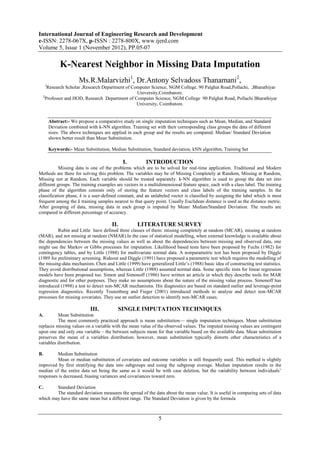The document discusses using k-nearest neighbor (k-NN) algorithm for missing data imputation. It compares the performance of mean, median, and standard deviation imputation techniques when combined with k-NN. The techniques are applied to group data of different sizes, and median and standard deviation show better results than mean substitution. Accuracy improves with larger group sizes and higher percentages of missing data. Median and standard deviation imputation have slightly better performance than mean imputation for missing data imputation when combined with k-NN.


![K-Nearest Neighbor in Missing Data Imputation
V. CONCLUSION AND FUTURE WORK
k-NN algorithm is one of the famous classifier for grouping up of data .Traditional Methods such us Mean/
Median and Standard Deviation is used to improve the performance of accuracy in missing data imputation. This can be
further enhanced by comparing with some other machine learning techniques like SOM, MLP.
REFERENCE
[1]. Allison, P.D-―Missing Data‖, Thousand Oaks, CA: Sage -2001.
[2]. Bennett, D.A. ―How can I deal with missing data in my study? Australian and New Zealand Journal of Public
Health‖, 25, pp.464 – 469, 2001.
[3]. Graham, J.W. ―Adding missing-data-relevant variables to FIML- based structural equation models. Structural
Equation Modeling‖, 10, pp.80 – 100, 2003.
[4]. Graham, J.W, ―Missing Data Analysis: Making it work in the real world. Annual Review of Psychology‖, 60, 549
– 576 , 2009.
[5]. Gabriel L.Schlomer, Sheri Bauman, and Noel A. Card : ― Best Practices for Missing Data Management in
Counseling Psychology‖ , Journal of Counseling Psychology 2010, Vol.57.No 1,1 – 10.
[6]. Jeffrey C.Wayman , ―Multiple Imputation For Missing Data : What Is It And How Can I Use It?‖ , Paper
presented at the 2003 Annual Meeting of the American Educational Research Association, Chicago, IL ,pp . 2 -16,
2003.
[7]. A.Rogier T.Donders, Geert J.M.G Vander Heljden, Theo Stijnen, Kernel G.M Moons, ―Review: A gentle
introduction to imputation of missing values‖ , Journal of Clinical Epidemiology 59 , pp.1087 – 1091, 2006.
[8]. Kin Wagstaff ,‖Clustering with Missing Values : No Imputation Required‖ -NSF grant IIS-0325329,pp.1-10.
[9]. S.Hichao Zhang , Jilian Zhang, Xiaofeng Zhu, Yongsong Qin,chengqi Zhang , ―Missing Value Imputation Based
on Data Clustering‖, Springer-Verlag Berlin, Heidelberg ,2008.
[10]. Richard J.Hathuway , James C.Bezex, Jacalyn M.Huband , ―Scalable Visual Assessment of Cluster Tendency for
Large Data Sets‖, Pattern Recognition ,Volume 39, Issue 7,pp,1315-1324- Feb 2006.
[11]. Qinbao Song, Martin Shepperd ,‖A New Imputation Method for Small Software Project Data set‖, The Journal of
Systems and Software 80 ,pp,51–62, 2007.
[12]. Gabriel L.Scholmer, Sheri Bauman and Noel A.card ―Best practices for Missing Data Management in Counseling
Psychology‖, Journal of Counseling Psychology, Vol. 57, No. 1,pp. 1–10,2010.
[13]. R.Kavitha Kumar, Dr.R.M Chandrasekar,―Missing Data Imputation in Cardiac Data Set‖ ,International Journal on
Computer Science and Engineering , Vol.02 , No.05,pp-1836 – 1840 , 2010.
[14]. Jinhai Ma, Noori Aichar –Danesh , Lisa Dolovich, Lahana Thabane , ―Imputation Strategies for Missing Binary
Outcomes in Cluster Randomized Trials‖- BMC Med Res Methodol. 2011; pp- 11: 18. – 2011.
[15]. R.S.Somasundaram , R.Nedunchezhian , ―Evaluation of Three Simple Imputation Methods for Enhancing
Preprocessing of Data with Missing Values‖, International Journal of Computer Applications (0975 – 8887)
Volume 21 – No.10 ,pp.14-19 ,May 2011.
[16]. K.Raja , G.Tholkappia Arasu , Chitra. S.Nair , ―Imputation Framework for Missing Value‖ , International Journal
of Computer Trends and Technology – volume3Issue2 – 2012.
[17]. BOB L.Wall , Jeff K.Elser – ―Imputation of Missing Data for Input to Support Vector Machines‖ ,
7](https://image.slidesharecdn.com/b05010507-121222001012-phpapp02/85/Welcome-to-International-Journal-of-Engineering-Research-and-Development-IJERD-3-320.jpg)